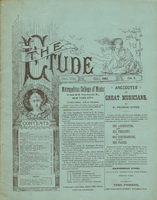BY FRANK L. EYER.
I do not want any one for a single instant to get a wrong impression from this article. I have the utmost respect for all the great tone poets and their works, and I ardently believe in the sanctity of our art and profession. But I do believe in cheerful musicians, and there is a comic side to music often, which is worthy of our consideration, and which will make us better musicians if judiciously indulged in now and then.
So many of us attend concerts nowadays with closed eyes and heavenly thoughts (?), and at the least disturbance raise a warning “s-sh,” and give the disturber a withering look of scorn and superiority. This is all fitting and proper, for concert goers should show respect for the performers and the works given by keeping quiet. But open your eyes, my brother, and look about you. Cast off your yard-long looks and watch the great orchestra. There is a comic side to it if you but look for it.
Look at those double-bass players. See how they bend down to their work. Look at those fellows pouring the water out of their horns; there is a storm coming and they are getting ready to help it. Here it comes, louder and louder, violins, ‘cellos, wind, brass, and drums. And now look at them,—each man working away as if his life depended on it—sawing, scraping, and blowing for dear life.
Listen to the bassoon. It is a little tale-bearer. “So-and-so did this; he did, he did,” it reiterates over and over. It is the clown of the orchestra, too, always relating funny little stories. No one better than Mozart or Beethoven was aware of this. If you ever have the blues my brother, and have an opportunity of hearing one of Mozart’s operas, go, and pay particular attention to the bassoon, and if you do not smile inwardly ere long, I am much mistaken.
Then there are the oboe and English horn. These fellows are pessimists, always speaking in that complaining tone, telling their little tales of woe.
The trumpets, too, how boisterous and noisy they are, like great, big boys, ready at a moment’s notice to join in some noisy frolic.
Opera, whether it profess to be comic or not, will furnish you much enjoyment if you are ready to receive it. A friend of mine once tried to convince me that a number of Wagner’s operas were intended for comic operas, only Wagnerites are so serious they cannot appreciate them as such. He mentioned “Siegfried,” and the next time I saw it I noticed its humorous side, and I laugh yet when I think of it.
The very fact of your sitting for about five hours, with not more than three persons on the stage at one time, with that immense orchestra blasting and scraping away, did seem like a big farce. The dwarf, Mime, appears to be suffering with a pain of a stomachial character, and Erda, standing in a cave with a mosquito net over her head, delivers advice to the old wanderer (Wotan) for nearly half an hour at a stretch.
In several of Wagner’s operas the changing of the stage scenery is hidden behind a cloud of steam, which escapes from a pipe which runs along the front of the stage close to the footlights. This is intended to represent clouds or mist, I believe; but I never could get rid of its association in my mind with washing day, and I never saw it but what I could always see in my mind’s eye washboards, tubs, boilers, and all the paraphernalia of “blue Monday.”
I have always considered the orchestral part of Mozart’s “Figaro” very amusing to listen to. The way it runs along telling its own little story, apparently regardless of the singers on the stage, is delightful. Especially does the finale of the first act amuse me. It is a quarrel scene, and the orchestra grumbles and quarrels to itself in an irresistible manner.
If we come into the concert field, comic instances are so numerous we can only mention a few of them.
In the first movement of Beethoven’s Eighth Symphony, this comic little figure occurs:—
In the second portion of the movement this figure is assigned to the bassoon. That instrument seems to consider it a good joke, and repeats it in such a manner as to make you laugh in spite of yourself.
Piano music has its comical aspect, too. Haydn and Beethoven are very fond of little jokes in their sonatas, which are too numerous too mention.
But my object in writing this article, was to cause you to turn your thoughts away from the serious side of music to its comical aspect. We must never lose sight of the seriousness of our art, but if we will every now and then look at its humorous side, we will be more cheerful and better musicians. Try it, my brother, and see if it is not so.




